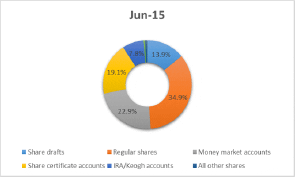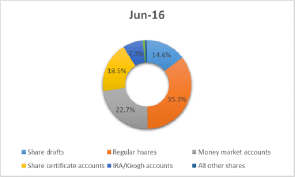Over the last 10 years the deposits in the credit union industry have experienced solid increases. In June of 2015 the savings balances at credit unions hit a milestone and topped $1 trillion. As of June 2016, deposits totaled nearly $1.1 trillion and increased 7.3% since the second quarter of 2015. The growth trend in deposits continues.
When modeling and forecasting interest rate risk, non-maturity share assumptions are a very significant component of the analysis. They also represent the area with the most unknown variables. NCUA is making some changes to the examiners workbook, updating how they will evaluate interest rate risk, and have developed some standard assumptions for non-maturity deposits. This does not remove the necessity for credit union management to make every effort to understand its own deposit composition, anticipate deposit behavior and rate sensitivities when market rates change, and make IRR model assumptions that are well thought out and supported.
The growth in deposits during the last 12 months represents approximately $72.1 billion dollars. Of the growth, 24% went into share drafts, 40% into regular shares, 20% into money markets, and only 10% into certificates of deposit. All asset groups posted growth, while credit unions in the asset group greater than $500 million had the greatest increase at over 10%. Credit unions in the $100 million to $500 million asset group had strong growth at 7.19% and those under $100 million grew at 5.21%. The June 2016 call report summary indicates the average cost of funds for the industry is at .26%. In spite of this very low yield, we continue to see credit union membership and deposits grow.
In 2008 certificates represented 33% of deposits and money markets were at 19%. Combined they represented 52% of deposits and historically have been considered rate sensitive funding. Currently the deposit composition for the industry has 19% in certificates and 23% in money markets, totaling 42% of all deposits. The distribution of the deposit growth over the last 12 months indicates fewer and fewer members are choosing to place their money into certificates.
NCUA reports during the 2nd quarter of 2016, “credit unions continued to move away from long-term investments as they increased lending to members.” The long-term asset ratio for credit unions with total assets from $50 million to $100 million is 26.1% and increases up to 33.4% for the largest credit unions. Overall, as the funding has moved into less rate-sensitive accounts and the system’s ratio of net long-term assets to total assets decreased another .4% in the last year, the potential interest rate risk in the system has decreased.
How deposits will behave in the future remains unpredictable. It is possible that during this prolonged low rate environment, depositors may have evolved and reprioritized safety, liquidity, and services over earnings. Conversely, deposits in regular shares and share drafts, which currently have a demonstrated low rate sensitivity, may move back into certificates or money markets as rates return to more normal levels and the delta between regular share and CD rates increases.
Having solid segmentation strategies in place and preparing to capitalize on the possibility that all funding is not rate sensitive will enable the credit union to preserve their net interest margin, balance services with rate, match funding sources to assets terms, and control interest rate risk. In addition, anticipating changes in member behavior and running alternative scenarios will be critical in planning and forecasting potential exposure to earnings when rates increase. Very little market research has been conducted or published to predict how deposits will behave when rates change, assuming we are in a new norm. Sensitivity testing major assumptions will assist to quantify the degree of risk to earnings if historical deposit behavior is not repeated in the future.
Current and historical trends support the assumption that a significant portion of credit union deposits are stable and a low cost funding source and we recommend modeling IRR using assumptions that are realistic based on current information. Tracking your credit union’s deposit composition and watching for positive as well as negative trends is going to be critical as the rate environment changes. Frequently evaluating and modifying the assumptions in your ALM model, if needed, will be essential in the measuring, monitoring, and management of interest rate risk.


